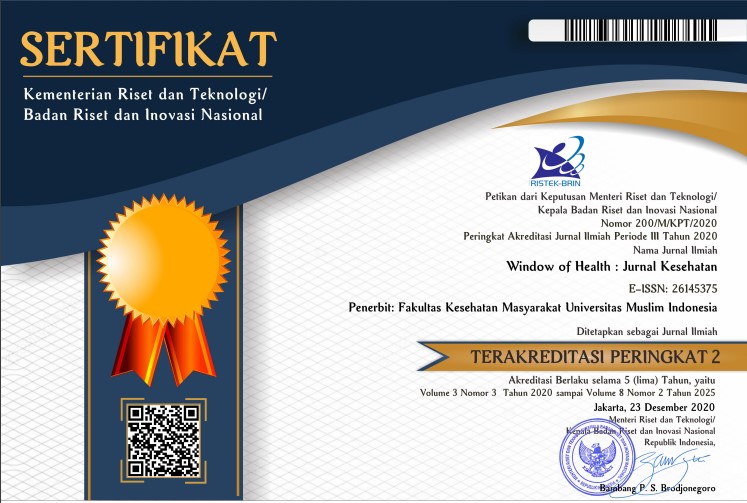The Relationship of Workload with the Quality of Nursing Services in Hemodialysis Installations
Abstract
The quality of nursing services for hemodialysis patients is determined by the role and performance of nurses. High workloads are often the reason nurses leave work, which can disrupt the continuity of patient care. A high workload can have a negative impact on the quality of nurses' work, while a balanced workload can improve the quality of work. This study used a cross-section design with a sample of 35 hemodialysis nurses at RSUD Dr. Soetomo. The research was carried out in the Hemodialysis room at Dr Soetomo Hospital, Surabaya. Research data regarding workload and service quality variables was collected through questionnaires. Research data was processed using Spearmen rho with a p-value ≤ 0.05. The statistical test results show that the p-value is 0.000, so it can be interpreted that H0 is rejected. This indicates a relationship between nurses' workload and the quality of hemodialysis services. The workload creates optimal nurse performance in carrying out actions. The performance of nurses in hemodialysis tasks, which are quite complex, with the number of patients being disproportionate to the number of nurses, has an effect on the quality of nursing services.
References
Zamroni, A. H., Nursalam, N. and Wahyudi AS. The Leadership and Performance of Nurses in The Hospital. Fundam Manag Nurs J. 2021;4(2):28.
Elfina, E., Syam, B. and Nasution SZ. Kepemimpinan Klinis terhadap Kualitas Pelayanan Keperawatan. J Telenursing. 2022;4(2):706–720.
Anik Inayati et all. Perilaku Caring Perawat Terhadap Tingkat Kepuasan Pasien Yang Menjalani Hemodialisis Pada Masa Pandemi Covid-19’. Peran Mikronutrisi Sebagai Upaya Pencegah Covid-19. 2021;11(1):1–8.
Nasirizad Moghadam K et al. Nursing physical workload and mental workload in intensive care units: Are they related? 2021;8(4):1625–1633.
Elias, S. R., Welly, W. F. and Tatura SNN. Faktor-Faktor Yang Berhubungan dengan Kelengkapan Pendokumentasian Asuhan Keperawatan. J Kesehat Med Saintika,. 2020;11(2):253–257.
Nursalam PD. Manajemen Keperawatan Aplikasi dalam Praktik Keperawatan Profesional. Merdeka S, editor. Jakarta;
KHandan, M., Eyni, Z. and Koohpaei A. Relationship between Spiritual Intelligence and Job Performance: A Case Study of Nurses and Nursing Aids in the Main University Hospital of Qom, Iran’, Health, Spirituality and Medical Ethics. https://jhsme.muq.ac.ir/article-1-152-en.html. 2017;4(3).
Nursalam. Metode Penelitian Ilmu Keperawatan: Pendekatan Praktis Edisi 5. Jakarta: Salemba Medika; 2020.
Rohmia V. Hubungan Beban Kerja, Sikap Kerja, dan Status Gizi dengan Kelelahan Kerja. Kesehat Masyaraka. 2019;30(28).
Nursalam. Manajemen Keperawatan: Aplikasi dalam Praktik Keperawatan Profesional. 6th edn. Jakarta: Salemba Medika; 2020.
Alghamdi MG. Nursing workload: A concept analysis’. J Nurs Manag. 2016;24(4):449–457.
Wahyuningsih S et al. Faktor-Faktor Yang Memengaruhi Beban Kerja Perawat Dalam Memberikan Asuhan Keperawatan Di Ruang Rawat Inap: Literature Review’. J UNTAN. 2021;1(1):23–35.
Sumah DF. Kecerdasan Spiritual Berkorelasi dengan Tingkat Kecemasan Pasien Gagal Ginjal Kronik yang Menjalani Hemodialisa di Ruang Hemodialisa RSUD dr. M. HAULUSSY Ambon’. J Biosainstek. 2020;2(1).
Mawikere, Y., Manampiring, A. E. and Toar JM. ‘Hubungan Beban Kerja Perawat Dengan Tingkat Kepuasan Pasien Dalam Pemberian Asuhan Keperawatan.’ J Keperawatan. 2021;9(1):71.
Izzata, N., Nursalam, N. and Fitryasari R. The Relationship between Workload and Social Support with Nurse Job Satisfaction in Hospital Inpatient Room’. Fundam Manag Nurs Journa. 2021;4(2):33.
Destiani, W., Mediawati, A. S. and Hara Permana R. The Mental Workload Of Nurses In The Role Of Nursing Care Providers. 2020;
Pundati, T. M., Tamtomo, D. and Sulaeman ES. Motivation, Competence, Workload, and Their Association with Nurse Performance in Dr. Arif Zaenudin Hospital, Surakarta’. J Heal Policy Manag. 2018;3(2):63–70.
Lehto RH et al. Hospice Employees’ Perceptions of Their Work Environment: A Focus Group Perspective. Int J Environ Res Public Health. 2020;17(17):1–16.
Ranjdoust S. The Relationship between Spiritual Intelligence and Emotional Intelligence with Performance of Female Nurses in Tabriz Hospitals in 2018’. J Pizhūhish dar dīn va salāmat. 2020;6(1):19.
Beni K et al. Spiritual Intelligence Roles to Improve the Quality of Nursing Care: A Systematic Review. J Ners. 2020;93.
Copyright (c) 2024 Tri Ratnanningsih, Faisal Ibnu , M.Maridi , Seriga Banjarnahor

This work is licensed under a Creative Commons Attribution-NonCommercial-ShareAlike 4.0 International License.








